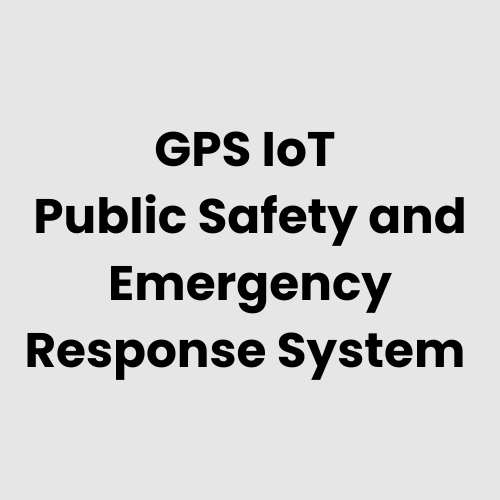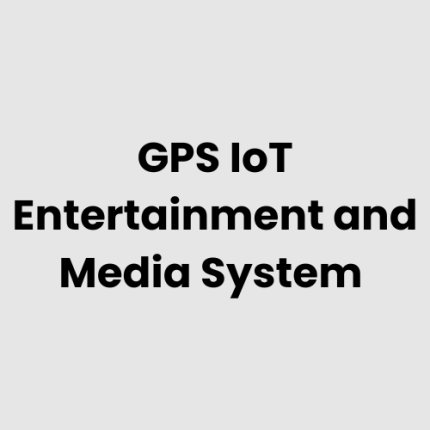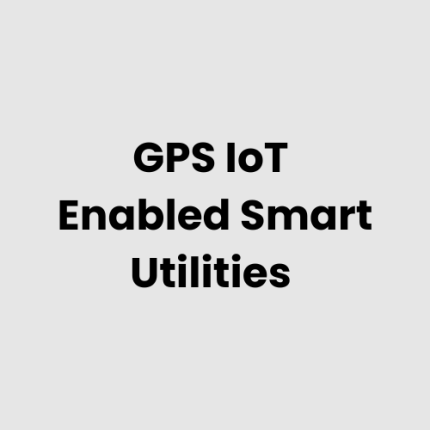Description
Technical Architecture of the GPS IoT Enabled Public Safety and Emergency Response
The GPS IoT Enabled Public Safety and Emergency Response system integrates GPS precision, IoT sensors, and advanced communication networks to enhance public safety and emergency operations. The architecture includes:
- Perception Layer: Utilizes GPS trackers, IoT sensors, and wearable devices to collect data such as location, health metrics, and environmental conditions.
- Communication Layer: Features real-time data transfer using LTE, 5G, Wi-Fi, and satellite communication for uninterrupted connectivity.
- Processing Layer: Includes edge computing for low-latency decision-making and cloud servers for large-scale data analytics and storage.
- Application Layer: Offers user-friendly dashboards, incident management software, and AI-driven analytics for rapid decision-making.
GAO Tek provides comprehensive solutions to customize and deploy this architecture for diverse emergency response needs.
List of Hardware for the GPS IoT Enabled Public Safety and Emergency Response
- GPS-enabled tracking devices
- Wearable health monitors (e.g., heart rate, temperature sensors)
- Environmental monitoring devices (e.g., air quality, radiation detectors)
- IoT cameras with AI capabilities
- Communication modules (LTE, 5G, Wi-Fi, satellite uplinks)
- Edge computing gateways
- Centralized and edge servers
- Emergency response drones with integrated GPS
- Incident command devices (tablets, rugged laptops)
- Backup power units (portable battery systems)
GAO Tek offers top-tier hardware, ensuring reliable performance in critical situations.
Physical Placement Considerations for Hardware
- GPS Trackers: Worn by personnel or mounted on vehicles for real-time tracking.
- Environmental Sensors: Deployed in high-risk areas, such as industrial zones or disaster-prone regions.
- Communication Modules: Strategically placed to ensure strong signal coverage, including remote areas.
- Edge Gateways: Positioned near emergency hubs for quick data processing.
- Drones: Stored in accessible locations for rapid deployment during emergencies.
- Command Devices: Centralized at emergency response centers for real-time coordination.
GAO Tek ensures optimal placement of hardware for maximum operational effectiveness.
Hardware Architecture of the GPS IoT Enabled Public Safety and Emergency Response
The hardware architecture integrates field-deployed IoT devices, GPS modules, and centralized control systems. Key features include:
- Field Layer: Devices such as sensors, cameras, and wearables collect real-time data.
- Network Layer: Ensures secure and rapid data transmission through multi-channel communication.
- Processing Layer: Incorporates edge and centralized servers for immediate analytics and large-scale data processing.
- Control Layer: Provides tools for incident management and seamless collaboration among response teams.
GAO Tek designs robust systems to meet demanding public safety and emergency scenarios.
Deployment Considerations
- Coverage: Ensure reliable connectivity in remote and urban environments.
- Interoperability: Integrate with existing emergency response systems.
- Scalability: Accommodate additional devices and sensors as needed.
- Durability: Use ruggedized hardware for harsh environments.
- Cybersecurity: Protect sensitive data with encryption and multi-factor authentication.
GAO Tek applies its expertise to deliver solutions tailored to diverse public safety challenges.
List of Relevant Industry Standards and Regulations
- NIST Cybersecurity Framework (CSF)
- NFPA 1221 (Standard for Emergency Services Communications)
- FCC Part 15 (Wireless Communication Compliance)
- ANSI/TIA-4957 (Public Safety Communications Standards)
- GDPR/CCPA (Data Privacy Regulations)
- ISO 22320 (Emergency Management Guidelines)
- OSHA Standards for Emergency Response
Local Server Version
For organizations prioritizing data privacy or operating in areas with limited connectivity, GAO Tek offers a local server version of the GPS IoT Enabled Public Safety and Emergency Response system. This setup includes on-premises servers for secure, offline data processing and storage. It ensures high availability and aligns with stringent security requirements.
Cloud Integration and Data Management
Our cloud-based solution offers real-time data accessibility, scalable storage, and centralized analytics for efficient emergency response coordination. Features include:
- Seamless Integration: Interconnects with IoT devices and command centers.
- Scalable Infrastructure: Grows with operational demands.
- AI and ML Analytics: Provides predictive insights for proactive response planning.
- Secure Access: Utilizes encryption and multi-layer authentication for data protection.
GAO Tek ensures reliable cloud integration to enhance situational awareness and decision-making capabilities.
GAO Case Studies of GPS IoT Enabled Public Safety and Emergency Response
Case Studies in the USA
Enhanced Emergency Dispatch in Chicago, Illinois
GAO Tek’s GPS IoT system improved emergency response times by integrating real-time location tracking for first responders. This implementation streamlined dispatch coordination, reducing response delays by 25% during critical incidents in urban areas.
Wildfire Management in Los Angeles, California
In Los Angeles, GPS IoT technology was utilized to monitor wildfire-prone areas. GAO Tek’s environmental sensors provided real-time data, enabling preemptive evacuations and resource allocation to mitigate damage.
Flood Response Optimization in Houston, Texas
Houston deployed GAO Tek’s IoT-enabled solutions to track water levels and predict flooding patterns. This system supported proactive community alerts and optimized rescue operations during heavy rainfall.
Public Safety Monitoring in New York City, New York
GAO Tek supported a large-scale implementation of IoT sensors and GPS trackers for public events in New York City. The system enhanced situational awareness and ensured rapid incident response in high-density crowds.
- Tornado Preparedness in Oklahoma City, Oklahoma
Oklahoma City leveraged GAO Tek’s GPS-enabled emergency response tools to monitor weather patterns and coordinate evacuation routes during tornadoes, significantly improving community safety. - Emergency Coordination in Miami, Florida
Miami integrated GAO Tek’s GPS IoT system into its emergency response network to monitor hurricane impact zones, track first responders, and prioritize recovery efforts post-disaster. - Traffic Incident Management in Atlanta, Georgia
In Atlanta, GAO Tek implemented GPS-based systems to manage traffic during emergencies. This technology allowed first responders to access real-time traffic data and choose optimal routes. - Disaster Relief in Phoenix, Arizona
GAO Tek’s IoT sensors and drones were deployed in Phoenix to survey disaster-affected areas, helping responders efficiently allocate resources and identify survivors. - Urban Safety in Denver, Colorado
Denver utilized GAO Tek’s GPS-enabled systems to monitor real-time safety conditions across the city, ensuring rapid response to public disturbances and natural emergencies. - Infrastructure Monitoring in Detroit, Michigan
GAO Tek provided IoT sensors to monitor critical infrastructure in Detroit, enabling immediate alerts for bridge or road collapses during emergencies. - Crisis Response in Las Vegas, Nevada
Las Vegas adopted GAO Tek’s GPS-enabled wearables for its emergency responders, ensuring accurate tracking and improved communication during large-scale public events. - Chemical Spill Management in Baton Rouge, Louisiana
Baton Rouge implemented GAO Tek’s GPS IoT system to monitor hazardous chemical spills, facilitating faster containment and reducing environmental impact. - Earthquake Preparedness in San Francisco, California
San Francisco integrated GAO Tek’s IoT sensors into its public safety network to detect seismic activity, enabling early alerts and faster response to earthquakes. - Community Safety in Seattle, Washington
GAO Tek assisted Seattle in deploying IoT-enabled public safety cameras and GPS tracking systems, enhancing crime prevention and community surveillance. - Resource Tracking in Nashville, Tennessee
Nashville implemented GAO Tek’s GPS IoT solutions to track emergency vehicles and equipment during large-scale events, ensuring efficient deployment of critical resources.
Case Studies in Canada
- Flood Management in Toronto, Ontario
GAO Tek partnered with Toronto to implement IoT sensors and GPS trackers along flood-prone areas. The system enabled timely evacuation warnings and improved resource allocation during emergencies. - Remote Area Emergency Monitoring in Calgary, Alberta
In Calgary, GAO Tek’s GPS IoT solutions were used to monitor remote areas for wildfires and other natural disasters. The system provided critical real-time data, enhancing emergency response coordination.
Navigation Menu for GPS IoT
- GPS IoT Trackers/Devices
- GPS IoT Tracking Accessories
- GPS IoT Tracking Resources
- GPS IoT – Cloud, Server, PC & Mobile Systems
Navigation Menu for IoT
- LORAWAN
- ZIGBEE
- Wi-Fi HaLow
- Z-WAVE
- BLE & RFID
- NB-IOT
- CELLULAR IOT
- GPS IOT
- IOT SENSORS
- EDGE COMPUTING
- IOT SYSTEMS
Our products are in stock and can be shipped anywhere in the continental U.S. or Canada from our local warehouse. For any further information, please fill out this form or email us.
We are actively looking for partners who are like us located in the U.S. and Canada. For more information on partnering with GAO, please visit Partner with GAO Tek Inc. It lists various ways to partner with GAO, such as OEM Partnerships, Technology Integration, Distribution and Reselling Opportunities, Presenting at the Leading Event Tek Summit, Joint R&D Projects, Training and Consulting Services, Industry-Specific Collaborations, Research and Academic Partnerships.



